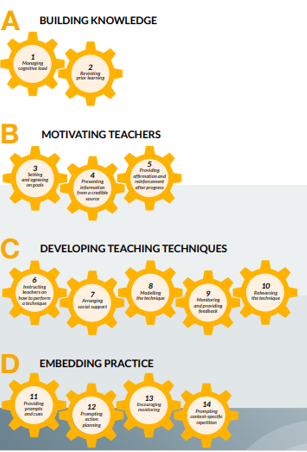Attending to the contextual factors – a case study on implementation and teacher development

Staff meetings are a part of all teachers’ weekly timetables – whether that be the full teaching team, departments or key stage phase meetings. I am not aware of many schools that do not allocate guided time to sitting down together. In my experience, due to packed timetables, staff meetings have always been a two-hour meeting at the end of a busy school day, by which point teachers are tired, over-stimulated and keen to get on with other classroom jobs.
Recommendation 2 of the EEF’s new School’s Guide to Implementation Guidance Report states that for any implementation to be successful, leaders must... develop systems and structures that support implementation. Systems and structures could refer to data collection systems, timetables or specific allocated meeting time. Allocated time is what we chose to focus on.
At the start of this academic year, the teaching staff began to codify what great teaching looks like in our school and have used this information along with The Great Teaching Toolkit and other codification guides/suggestions to help guide teachers to identify areas for development, and to work on improving specific domains of teaching. Teachers are split into groups and in our weekly staff meeting, we begin by sitting to discuss progress against their small progress step, support each other and identify their next step. Following this, I then run a session focusing on a whole school area of PD; for example, we have a half-termly focus on ‘checking for understanding’ followed by a weekly session on ‘effective routes for checking’.
What does a session look like?
We now have two thirty-minute workshops a week: one which is led by our senior teachers, with a focus on curriculum development; the other which I lead, on Teacher Development and Deliberate Practice. As a SLT, we aim to ensure we use the EEF Effective Professional Development Guidance document, in particular the mechanisms (see below and here).

We aim to include at least one mechanism from all four areas in each session. This has resulted in focused staff meetings/workshops which have a clear and consistent structure, but also last no more than the agreed thirty minutes. We have found that we have been able to do this for both of our weekly staff workshops: Curriculum and Teacher Development.
Structure
An average Teacher Development staff workshop follows the following structure:
- Meet in Teaching Development groups, revisit previous sessions and discuss the area they have been working on that week. If peer drop-ins have occurred, then feedback is shared and discussed.
- Outline the aims for the session.
- Break down the small developmental step we are looking at in the session (decomposition) and share/discuss any relevant research/literature.
- Share and analyse representations, if possible, against a success criteria – based upon our work on codifying great teaching within our context.
- Rehearse/practise how this step will be embedded in classrooms. This has been the trickiest element, and we are just at the beginning of our journey with this. However, where we have used it, it has proved powerful, and we are beginning to see the impact that rehearsal can have.
I am a big advocate of the EEF Teacher Development guidance and have found that by including the mechanisms in our staff meetings, alongside a lot of work around codifying what we think great teaching looks like at Rodings, we have not just seen a positive impact in attainment and progress in our pupils, but have begun to shift the dial with regards to creating a truly open and positive culture around teaching and learning.
Most importantly perhaps, we are well underway with our journey to having a clear understanding of what we think great teaching looks like, and how to get there.
Written by Darryl Crawley
This blog post was written by Darryl Crawley in his role as Deputy Headteacher at Rodings Primary School, with responsibility for Teaching and Learning. Darryl has recently taken up his first Headship at Heathlands Church of England Primary School in Essex.
Read our other blog posts here.
